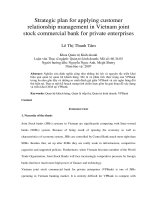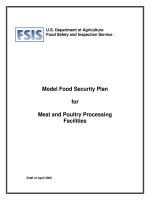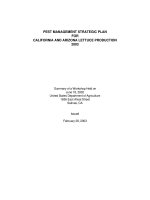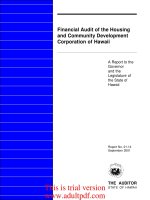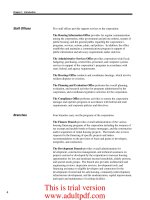Final version 2015 2019 consolidated plan for housing and community development in suburban monroe county
Bạn đang xem bản rút gọn của tài liệu. Xem và tải ngay bản đầy đủ của tài liệu tại đây (4.91 MB, 314 trang )
Consolidated Plan
OMB Control No: 2506-0117 (exp. 07/31/2015)
MONROE COUNTY
1
Executive Summary
ES-05 Executive Summary - 91.200(c), 91.220(b)
1.
Introduction
Two thousand and fifteen marks the fortieth year that Monroe County has received an allocation from
the Community Development Block Grant (CDBG) program. It also marks the twenty-fourth year that
Monroe County has been a participating jurisdiction as part of the HOME Investment Partnerships
Program (HOME). Combined with the Emergency Solutions Grants (ESG), and program income these
programs help Monroe County channel approximately $3 million annually into suburban towns and
villages that comprise the Monroe County Consolidated Plan Consortium in support of housing, public
works, economic development and community services programs that primarily benefit low to
moderate-income households, seniors and persons with special needs.
Funding for these programs is provided through the U.S. Department of Housing and Urban
Development (HUD). In order to remain compliant with the Consolidated Planning Regulations, which
cover these federal allocations, Monroe County is required to complete a five-year strategic plan and
annual action plans for the program years covered by the five-year plan. The five-year strategic plan
covers overall program priorities and long-term initiatives, while the annual action plan addresses
projects funded on an annual basis and new program initiatives for the program year.
Monroe County Community Development (CD) uses the Econ Planning Suite software provided by HUD
to complete its strategic and annual Plans, as well as the Consolidated Annual Performance and
Evaluation Report (CAPER) each year. The complete document includes the 2015-2019 Strategic Plan,
the 2015 Action Plan, needs tables associated with the plans, and a separate appendix that includes all
of the demographic and housing related charts.
The purpose of Monroe County’s 2015-2019 Strategic Plan is to communicate a clear vision to residents
of the analysis of community development and housing needs, the intended use of federal dollars to
meet these needs and to encourage public commentary in this endeavor. Monroe County has
established an active citizen participation process to solicit public commentary on all relevant aspects of
the programs. The Strategic Plan represents a coordinated effort by Monroe County to include input
from public and private sources throughout the community in the planning of housing and community
development programs. The Plan also serves as a reporting mechanism to HUD on the planning and
evaluation of programs.
Consolidated Plan
OMB Control No: 2506-0117 (exp. 07/31/2015)
MONROE COUNTY
2
For purposes of the Strategic Plan, goal numbers have been projected for each of the five years covered
by this plan. Goal numbers will be adjusted annually and reflected in the Action Plan for that program
year to cover the activities and funds available for specific program areas.
2.
Summary of the objectives and outcomes identified in the Plan
Program Goals
CDBG, HOME and ESG funds will be directed toward accomplishing the following primary program goals
and objectives during the 2015-2019 period:
a)
Develop affordable rental and home ownership opportunities for all low to moderate-income
residents, with a priority focus on the development of housing in towns and villages that do not
currently provide affordable rental units that have been financed, in part, through the County's CDBG
and/or HOME Program:
b)
Repair and conserve existing housing stock
c)
Improve access to and quality of public facilities
d)
Provide essential utility infrastructure in lower income areas
e)
Provide job training and economic development opportunities for low to moderate-income
persons and persons with special needs
f)
Provide essential public services, particularly those that promote home ownership, fair housing
and housing stability
g)
Revitalize deteriorated neighborhoods
The County's key strategies developed to meet CDBG, HOME and ESG goals to assist low to moderateincome families, elderly, and persons with special needs include: improving existing housing conditions
and preserving housing stock through the HOME Investment Partnerships Program; public facility and
accessibility improvements in suburban towns and villages; utility infrastructure improvements;
reducing costs for rental housing projects involving real property acquisition, certain pre-construction
costs, off-site improvements and limited on-site improvements, and building renovation/conversion or
construction to facilitate the provision of affordable rental units; and, increasing homeownership and
rental housing opportunities for these groups through the provision of programs such as First-Time
Homebuyer and Affordable Rental Housing Development.
3.
Evaluation of past performance
Consolidated Plan
OMB Control No: 2506-0117 (exp. 07/31/2015)
MONROE COUNTY
3
Projects funded with CDBG, HOME and ESG grants have had a very positive effect on the individuals and
communities served. These projects implemented our primary program goals and objectives in housing,
economic development, community services and public works/facility improvements.
The Home Improvement Program helps over 70 low to moderate-income residents make necessary
home repairs in a typical year. CDGB and HOME funding is used for this program. The repairs made
under the home improvement program allow people who have no other options make essential repairs
that allow them to stay in their homes.
Neighborhood and utility improvements are a high priority for Monroe County because of their
importance of preserving neighborhoods. There are a large number of communities that have
deteriorated infrastructure due to age. Monroe County uses CDBG funding to improve roads, sidewalks
and sewers in low income areas. This funding helps local governments undertake projects they would
not be able to do because of funding limitations.
Monroe County undertakes a number of activites through a contract with The Housing Council @
Pathstone. The Expanding Housing Opportunity Program, the Foreclosure Prevention and the Home
Equity Conversion Mortgage (HECM) Counseling Program and the Monroe County Homeownership
Assistance Program help expand housing opportunity for low to moderate-income residents. These
programs serve over 1,000 residents annually.
Assisting elderly persons is a goal of Monroe County's program. Through a contract with Lifespan,
Monroe County has made safety improvements and security modifications to the homes of hundreds of
low-mod income senior homeowners to allow them to contiue to reside independently in their
homes. Lifespan also runs the "Don't Be Scammed" prevention, intervention and education program
where citizens are trained in the identification and avoidance of financial scams. This program,
presented at numerous senior centers serves approximately 1500 people annually.
The key to CDBG employment strategies lies in adopting and actively participating in Monroe County’s
economic development initiatives while identifying community resources to implement them. We have
increased support for major employment efforts, which are integrated into the goals and objectives of
the Economic Development Division (ED) and its resources. Staff concentrates on County programs
designed to create and retain jobs.
Additionally, ED Loan funds are used in conjunction with CDBG Section 108 Loan Guarantee authority,
CDBG grants for utility infrastructure, financing from Monroe County’s Industrial Development Agency
(COMIDA), the New York State Urban Development Corporation and the SBA 504 Program. Another
strategy involves enhancing ED Loan funds through CDBG participation and the use of resources from
other County initiatives created to spur economic growth. They are: the GreatRate Interest Subsidy
Program, the GreatRebate Program, the Enhanced Jobs Plus Property Tax Abatement, the Monroe Fund,
and programs on foreign trade zone assistance.
Consolidated Plan
OMB Control No: 2506-0117 (exp. 07/31/2015)
MONROE COUNTY
4
Another important goal of Monroe County's is preventing homelessness and helping those who are
homeless. ESG funding has supported the Rapid Rehousing Partnership Program, community wide
coordinated access. The County continues to work in concert with the City of Rochester and the CoC to
maximize the impact of our limited program resources.
4.
Summary of citizen participation process and consultation process
The Consolidated Plan Steering Committee plays an integral role in the development of the Strategic
Plan. The Steering Committee is comprised of town and village officials who are members of the
County's Community Development Consortium. The Steering Committee is a vital consultant on the
identification of municipal needs of low/mod income families, senior citizens, disabled persons and
homeless persons, the identification of existing resources to meet the needs, the formulation of
objectives and strategies, and the evaluation of the Plan and program assessment.
Additionally, individual meetings are held with select Steering Committee members. This provides an
opportunity to have in depth conversations about the program and get their thoughts relative to their
particular community.
Monroe County holds two public hearings annually at convenient, fully accessible locations. Bilingual
interpreters will be provided upon request to translate policies and program requirements for nonEnglish speaking residents. The first hearing in January is held to notify the public of the amount of
CDBG, HOME and ESG funds that Monroe County expects to receive from HUD. The second public
hearing, held in May, encourages the public to review and comment on the draft Strategic Plan and
Action Plan. Commenters receive a response from the County within 30 days of submitting
comments. The final Strategic Plan and Action Plan are not submitted to HUD without consideration
and/or implementation of concerns and suggestions from citizens, public agencies and other interested
parties.
Review and Approval Process - The Strategic Plan is reviewed and approved by the County Executive and
the Monroe County Legislature. All meetings of the Legislature and its standing committees are open to
the public and start with a public forum. The Draft Plan is made available to the public for review and
comment during the official 30-day public comment period and a public hearing is held in May each
year. The Steering Committee reviews, expresses commentary and ultimately endorses the Draft Plan in
May. The CD staff responds to comments after the 30 day comment period. It is then reviewed, revised
and approved by several Legislative committees prior to its final approval by the County Legislature in
June. The Draft Plan is revised to incorporate all comments and sent to HUD each year.
5.
Summary of public comments
There were numerous individuals who praised the past performance of the program, and expressed
satisfaction with what it has done for the community at large. Several community members had
questions about the various programs administered by Monroe County, including the Home
Consolidated Plan
OMB Control No: 2506-0117 (exp. 07/31/2015)
MONROE COUNTY
5
Improvement Program, fair housing, and other services. Others mentioned the fact that there are over
850 mobile homes in Penfield, and that this is a viable option for individuals suffering from housing
affordability problems. It was expressed that raising the maximum grant amount to $20,000 would be
sufficient for conducting housing rehab.
6.
Summary of comments or views not accepted and the reasons for not accepting them
No comments were not accepted at the public hearings.
7.
Summary
Monroe County is excited about the new consolidated plan, and the opportunities that it will provide for
continued community development throughout the county. Readers of this plan will see that the words
contained in this plan have become, and will continue to become actions taken by Monroe County to
improve the community at large.
Consolidated Plan
OMB Control No: 2506-0117 (exp. 07/31/2015)
MONROE COUNTY
6
The Process
PR-05 Lead & Responsible Agencies - 91.200(b)
1.
Describe agency/entity responsible for preparing the Consolidated Plan and those
responsible for administration of each grant program and funding source
The following are the agencies/entities responsible for preparing the Consolidated Plan and
those responsible for administration of each grant program and funding source.
Agency Role
Name
CDBG Administrator
MONROE COUNTY
HOME Administrator
MONROE COUNTY
ESG Administrator
MONROE COUNTY
Department/Agency
Department of Planning and
Development
Department of Planning and
Development
Department of Planning and
Development
Table 1 – Responsible Agencies
Narrative
Monroe County is the lead agency that oversees the Consolidated Plan through the six-person
Community Development (CD) Division of the Department of Planning and Development. Programs are
administered by the CD staff with assistance from the three other divisions of the Planning and
Development Department, as well as municipal consortium members and private sector
subrecipients. CD staff administers the Home Improvement Program and contracts with towns, villages,
subrecipients and first-time homebuyers. The Economic Development (ED) Division of the Department
administers the CDBG-funded ED Grant and Loan Fund, the Section 108 Loan Guarantee Program and a
wide variety of County business incentive programs. The Planning Division evaluates municipal planning
and development activities including CDBG infrastructure projects and HOME-funded affordable rental
developments. The Workforce Development Division of the Department serves as a resource for
programs and other funds that address employment and training needs of the unemployed and
underemployed.
Non-profit subrecipients responsible for administering programs covered by the Plan include The
Housing Council @ Pathstone and Lifespan.
Consolidated Plan
OMB Control No: 2506-0117 (exp. 07/31/2015)
MONROE COUNTY
7
Consolidated Plan Public Contact Information
Jeffery L. McCann, Community Development Manager, Monroe County Department of Planning and
Development, 50 W. Main Street. Rochester, NY 14614, (585) 753-2041 Suite 8100
Consolidated Plan
OMB Control No: 2506-0117 (exp. 07/31/2015)
MONROE COUNTY
8
PR-10 Consultation - 91.100, 91.200(b), 91.215(l)
1.
Introduction
Monroe County is fortunate to be home to many agencies, organizations, and groups that focus on the
wellbeing of the community as a whole. Monroe County Community Development staff make it a
priority to include as many of these groups, agencies, and organizations in the planning process as
possible.
Provide a concise summary of the jurisdiction’s activities to enhance coordination between
public and assisted housing providers and private and governmental health, mental health
and service agencies (91.215(I)).
Monroe County will continue to meet and coordinate with public and assisted housing providers within
the Monroe County service area. These housing providers keep Monroe County informed about projects
the housing providers are taking on at any given time. For example, the Rochester Housing Authority
(RHA) has informed Monroe County that it will be doing the following in the coming years:
Renovation of sixteen units at the housing location located on Federal Street,
Renovations are being planned for a four unit building on Garson Avenue,
RHA is in the process of replacing tubs at the Kennedy Tower location, and multiple roofing
jobs at some of the other properties it owns,
RHA is also in the process of reviewing and assessing its energy performance, and may be
entering into a contract to upgrade some of its mechanical and other energy use items/systems.
Describe coordination with the Continuum of Care and efforts to address the needs of
homeless persons (particularly chronically homeless individuals and families, families with
children, veterans, and unaccompanied youth) and persons at risk of homelessness
Monroe County has been an active participant with the Continuum of Care since its inception, holding
several leadership positions. The County coordinates its planning efforts to address the needs of
homeless persons in a number of ways, including shared strategic planning and prioritization, joint
planning for ESG and CoC Programs and joint participation with the CoC in community initiatives.
Monroe County coordinates with the CoC to meet the needs of other special populations (veterans,
unaccompanied youth, families with children). The VA is very actively involved in meeting the needs of
homeless veterans in the Monroe County region, offering a wide range of services and supports, from
outreach through permanent housing options. The VA has a strong working relationship with the
Veterans Outreach Center to ensure that the needs of homeless veterans who choose not to use, or are
ineligible for, VA benefits may receive the services they need. Agencies serving unaccompanied youth
have a number of mechanisms in place that constitute a network of services for this population.
Consolidated Plan
OMB Control No: 2506-0117 (exp. 07/31/2015)
MONROE COUNTY
9
Describe consultation with the Continuum(s) of Care that serves the jurisdiction's area in
determining how to allocate ESG funds, develop performance standards and evaluate
outcomes, and develop funding, policies and procedures for the administration of HMIS
Monroe County actively consults with a variety of non-profits, social service providers, community
residents, and governmental gencies to determine the needs of community members, and better
allocate entitlement resources.
Our community has systematically been developing tools that will assist in the coordination of homeless
services. Most providers, including faith based and non-HUD funded providers are using HMIS to enter
and share data so we can reduce duplication and increase efficiencies. Most provider groups have
participated in work groups that are tasked with developing common assessment tools, developing a
single point of access and developing competencies on industry best practices by offering training and
sharing expertise between organizations. Several task forces have been established to take a closer look
at special initiatives such as prioritizing the chronically homeless for first available housing. This has
resulted in agency leaders agreeing to change policies to prioritize the chronically homeless for
permanent housing. Another example of a task force is the Rapid re-housing collaboration. This group
is working to develop a continuum that alleviates duplication of effort and has been able to identify
resources other than HUD funds to leverage our efforts. The County, in partnership with the City of
Rochester, has provided funding for the implementation of a "Coordinated Intake and Assessment
System", known as Coordinated Access. Coordinated Access is one of the joint priorities of the County
and the CoC. This initiative is intended to improve access to homeless services for those in need, divert
at-risk persons from entering the system whose needs may be better met elsewhere and decrease the
length of a homeless episode by improving shelter competencies in assessing clients and developing exit
strategies to move persons to permanent housing options. Attention is paid through Coordinated
Access to the needs of special populations, taking advantage of the specialized services in the
community for veterans, families with children, and unaccompanied youth. The Coordinated Access
initiative has begun to implement changes in the community for accessing emergency shelter
services, directing homeless individuals to the community’s 2-1-1 call center as the primary point of
access that will work to divert individuals from entering the system, and arrange for shelter placement
for those who cannot be diverted. This initiative is also implementing the use of a common assessment
tool among shelters (VI-SPDAT) to better inform exit strategies for the most appropriate next step
housing option. Some members of the Continuum of Care and HSN are working closely with DSRIP staff
to figure out how we can leverage existing resources to help reduce Medicaid costs through a
transitional supportive living project. The actual strategies are still being developed however the existing
homeless system could help to reduce Medicaid costs by targeting individuals with high risk factors for
permanent, supportive housing. The goal is to reduce the time a person stays in a hospital setting,
particularly those who experience extended hospital stays due to the lack of a safe housing environment
where they may receive in-home support to stabilize their condition.
Consolidated Plan
OMB Control No: 2506-0117 (exp. 07/31/2015)
MONROE COUNTY
10
2.
Describe Agencies, groups, organizations and others who participated in the process
and describe the jurisdictions consultations with housing, social service agencies and other
entities
Consolidated Plan
OMB Control No: 2506-0117 (exp. 07/31/2015)
MONROE COUNTY
11
Table 2 – Agencies, groups, organizations who participated
1 Agency/Group/Organization
Rochester Housing Authority
Agency/Group/Organization Type
Housing
PHA
What section of the Plan was addressed
by Consultation?
Housing Need Assessment
Lead-based Paint Strategy
Public Housing Needs
How was the
Agency/Group/Organization consulted
and what are the anticipated outcomes
of the consultation or areas for improved
coordination?
Monroe County works with the Rochester Housing
Authority on a regular basis to discuss the consolidated
plan and coordination of services. The Rochester
Housing Authority administers the local voucher
program.
2 Agency/Group/Organization
Fairport Urban Renewal Agency
Agency/Group/Organization Type
Housing
PHA
What section of the Plan was addressed
by Consultation?
Housing Need Assessment
Lead-based Paint Strategy
Public Housing Needs
How was the
Agency/Group/Organization consulted
and what are the anticipated outcomes
of the consultation or areas for improved
coordination?
The Fairport Urban Renewal Agency administers the
voucher program for eastern Monroe County excluding
Irondequoit and the City of Rochester.
3 Agency/Group/Organization
Agency/Group/Organization Type
Consolidated Plan
OMB Control No: 2506-0117 (exp. 07/31/2015)
The Rochester/Monroe County Homeless Continuum of
Care
Services - Housing
Services-Children
Services-Elderly Persons
Services-Persons with Disabilities
Services-Persons with HIV/AIDS
Services-Victims of Domestic Violence
Services-homeless
Services-Health
Services-Education
Services-Employment
Service-Fair Housing
Services - Victims
Publicly Funded Institution/System of Care
MONROE COUNTY
12
What section of the Plan was addressed
by Consultation?
Housing Need Assessment
Lead-based Paint Strategy
Homelessness Strategy
Homeless Needs - Chronically homeless
Homeless Needs - Families with children
Homelessness Needs - Veterans
Homelessness Needs - Unaccompanied youth
Non-Homeless Special Needs
Anti-poverty Strategy
How was the
Agency/Group/Organization consulted
and what are the anticipated outcomes
of the consultation or areas for improved
coordination?
Monroe County CD staff is actively involved with the
Rochester / Monroe County Homeless Continuum of
Care (CoC). CoC meetings are held to discuss homeless
data, and program delivery. The coordination between
the County and the CoC will help improve conditions,
and reduce the number of unsheltered homeless
individuals within Monroe County, including increased
coordination of ESG to strengthen efforts, enhancing
services, reducing duplication of services, and
maximizing resources.
4 Agency/Group/Organization
Monroe County Youth Bureau
Agency/Group/Organization Type
Services-Children
Child Welfare Agency
What section of the Plan was addressed
by Consultation?
Housing Need Assessment
Homelessness Strategy
Homeless Needs - Families with children
Homelessness Needs - Unaccompanied youth
Non-Homeless Special Needs
How was the
Agency/Group/Organization consulted
and what are the anticipated outcomes
of the consultation or areas for improved
coordination?
Monroe County works with the Monroe County Youth
Bureau to discuss how it can play a roll in implementing
the portions of the plan that relate to the youth.
5 Agency/Group/Organization
Office for People with Developmental Disabilities
Agency/Group/Organization Type
Services-Persons with Disabilities
Publicly Funded Institution/System of Care
What section of the Plan was addressed
by Consultation?
Non-Homeless Special Needs
Consolidated Plan
OMB Control No: 2506-0117 (exp. 07/31/2015)
MONROE COUNTY
13
How was the
Agency/Group/Organization consulted
and what are the anticipated outcomes
of the consultation or areas for improved
coordination?
6 Agency/Group/Organization
Monroe County works with OPWDD to develop
strategies to improve conditions for individuals with
special needs within Monroe County.
Office of Mental Health
Agency/Group/Organization Type
Services-Children
Services-Elderly Persons
Services-Persons with Disabilities
Services-Persons with HIV/AIDS
Services-Victims of Domestic Violence
Services-homeless
Services-Health
Services-Education
Services - Victims
What section of the Plan was addressed
by Consultation?
Homelessness Strategy
Homeless Needs - Chronically homeless
Homeless Needs - Families with children
Homelessness Needs - Veterans
Homelessness Needs - Unaccompanied youth
Non-Homeless Special Needs
How was the
Agency/Group/Organization consulted
and what are the anticipated outcomes
of the consultation or areas for improved
coordination?
The Office of Mental Health has been an active
member of the chronically homeless workgroup in
providing assistance to the chronically homeless.
Identify any Agency Types not consulted and provide rationale for not consulting
Agency types related specifically to HOPWA were not consulted with as a result of the fact that Monroe
County does not recieve funding for this program.
Consolidated Plan
OMB Control No: 2506-0117 (exp. 07/31/2015)
MONROE COUNTY
14
Other local/regional/state/federal planning efforts considered when preparing the Plan
Name of Plan
Lead Organization
Continuum of
Care
Rochester / Monroe
County Homeless
Continuum of Care
Monroe County
Section 3
How do the goals of your Strategic Plan overlap with the goals
of each plan?
The Section 3 program requires that recipients of certain HUD
financial assistance, to the greatest extent possible, provide job
training, employment, and contract opportunities for low- or
very-low income residents in connection with projects and
activities in their neighborhoods.
Table 3 – Other local / regional / federal planning efforts
Describe cooperation and coordination with other public entities, including the State and any
adjacent units of general local government, in the implementation of the Consolidated Plan
(91.215(l))
State agencies, including the Office for People with Developmental Disabilities were consulted with, and
are in communication with Monroe County regularly in order to provide better service delivery for
community members in Monroe County.
Narrative
Consolidated Plan
OMB Control No: 2506-0117 (exp. 07/31/2015)
MONROE COUNTY
15
PR-15 Citizen Participation - 91.401, 91.105, 91.200(c)
1.
Summary of citizen participation process/Efforts made to broaden citizen participation
Summarize citizen participation process and how it impacted goal-setting
The Community Development Department (CD) followed its established Citizen Participation Process to formulate these priorities and strategies,
incorporating any public comments received at the January and May 2015 public hearings and Steering Committee meetings.
The draft plan is released on or around May 6th, at the same time the matter is introduced in the Legislature, with a thirty-day comment
period. Public notice is provided at the time the plan is released, and the public hearing and steering committee will be held during this time, as
well. The process concludes with the incorporation of public comments before the Legislature acts on the matter at its June meeting.
The Steering Committee serves in an advisory capacity in regard to the County’s Community Development initiatives and is charged with the
following responsibilities: analyze, measure and determine housing, public works, ADA and facility improvements, economic development,
planning and public service needs for their residents, with an emphasis on the needs of low-mod income, elderly, disabled and homeless persons
in their communities; identify existing resources to meet the needs as well as existing gaps in services unmet by other programs; advise CD Staff
in the formulation of objectives, strategies; assist in the evaluation of the Consolidated Plan; and, help to assess the effectiveness of meeting the
established needs with the use of Consolidated Plan resources.
The core membership of the Steering Committee will continue to include the Supervisors and Mayors of municipalities that are members of the
consortium. In addition, with the advent of the Internet and distribution of information on compact disc, methods of information distribution
have expanded, and it is necessary to review our information distribution system to ensure that it is as accessible, comprehensive and cost
effective as possible.
Consolidated Plan
OMB Control No: 2506-0117 (exp. 07/31/2015)
MONROE COUNTY
16
Citizen Participation Outreach
Sort Order
Mode of Outreach
Target of Outreach
Consolidated Plan
OMB Control No: 2506-0117 (exp. 07/31/2015)
Summary of
response/attendance
MONROE COUNTY
Summary of
comments received
Summary of comments
not accepted
and reasons
17
URL (If
applicable)
Sort Order
Mode of Outreach
Target of Outreach
Summary of
response/attendance
1
Public Hearing
Persons with
disabilities
Approximately 35
There were no
people attended the
comments
public hearing.
received.
Presentations were
given by Monroe
County Community
Development,
Lifetime Assistance
Incorporated, a local
agency that provides
services to
developmentally
disabled residents,
and Rochester
Cornerstone Group, a
local company that
specializes in low
income housing.
There was a positive
response to all of the
presentations. The
two agencies that
presented at the
hearing have been
recipients of the
CDBG program and
their presentations
showcased the
MONROE COUNTY
Nontargeted/broad
community
Consolidated Plan
OMB Control No: 2506-0117 (exp. 07/31/2015)
Summary of
comments received
Summary of comments
not accepted
and reasons
N/A
18
URL (If
applicable)
Sort Order
Mode of Outreach
Target of Outreach
Summary of
response/attendance
Summary of
comments received
2
Public Meeting
Minorities
On Wednesday
January 21, 2015,
Monroe County
Community
Development
Manager Jeffery
McCann spoke before
the Chester F. Carlson
YMCA Retirees Club.
A racially diverse
crowd of
approximately 20
members attended
and viewed the
presentation
presented a week
earlier at the Steering
Committee Meeting.
Members of the
retirees group
asked specific
questions about
Home
Improvement
Program and other
services we target
to senior citizens.
The topic of fair
housing was also
discussed, as there
was an article in
that day's edition of
the Democrat and
Chronicle
newspaper about a
local bank reaching
a settlement with
the New York State
Attorney General's
office regarding
redlining. There
were supportive
comments about
the fair housing
programs
administered by
Persons with
disabilities
Nontargeted/broad
community
Consolidated Plan
OMB Control No: 2506-0117 (exp. 07/31/2015)
MONROE COUNTY
Summary of comments
not accepted
and reasons
N/A
19
URL (If
applicable)
Table 4 – Citizen Participation Outreach
Consolidated Plan
OMB Control No: 2506-0117 (exp. 07/31/2015)
MONROE COUNTY
20
Needs Assessment
NA-05 Overview
Needs Assessment Overview
The needs assessment section of Monroe County's 5 year consolidated plan will review information
about the issues facing community members in Monroe County. In order to successfully complete the
needs assessment section of this plan, Monroe County will analyze various housing issues, including
overcrowding, lacking a complete kitchen or plumbing, and cost burden. It will look to see if there are
any groups of people within Monroe County that are disproportionately burdened with housing
problems, and it will review homeless and non-housing special needs within this section of the plan.
The findings of this section of the plan will inform the decisions made by the County in forming its goals
and strategies for its 5 year consolidated plan.
Map of Low-Moderate Income areas in Monroe County
Consolidated Plan
OMB Control No: 2506-0117 (exp. 07/31/2015)
MONROE COUNTY
21
NA-10 Housing Needs Assessment - 24 CFR 91.405, 24 CFR 91.205 (a,b,c)
Summary of Housing Needs
A good community development plan must take into consideration the needs of the community in terms
of housing quality. The Department of Housing and Urban Development has indicated that there are
three categories of housing problems, including lacking kitchen facilities, overcrowding, and cost
burden. Analyzing these problems will help the Monroe County consortium prepare a plan that will
reduce the occurrences of these problems in Monroe County. This section of the plan will give an
overview of housing issues within Monroe County. It will do so by comparing income levels to rates of
housing problems within Monroe County.
Demographics
Population
Households
Median Income
Base Year: 2000
Most Recent Year: 2011
531,326
207,095
$0.00
515,570
197,727
$0.00
% Change
3%
5%
Table 5 - Housing Needs Assessment Demographics
Data Source:
2000 Census (Base Year), 2007-2011 ACS (Most Recent Year)
Demographic Data Analysis
Demographic Data Analysis
According to the demographic data provided by the American Community Survey (ACS), the population
in the Monroe County consortium has increased by 4%, the number of households has increased by 6%,
and the median income has increased by 16% between 2000 and 2011. While this information is
promising, it should be noted that the inflation rate between these years was 30.6%. This means that
although community members in Monroe County consortium have more money than they did in the
year 2000, their purchasing power is lower.
The data does reveal something positive - that the population has increased at a rate of 4% over the
time in question, which is higher than the rate of the rest of the North East portion of the United States
at that time (3.2%).
Number of Households Table
Total Households *
Consolidated Plan
OMB Control No: 2506-0117 (exp. 07/31/2015)
0-30%
HAMFI
15,565
>30-50%
HAMFI
18,440
MONROE COUNTY
>50-80%
HAMFI
32,230
>80-100%
HAMFI
21,465
>100%
HAMFI
119,430
22
0-30%
HAMFI
4,099
545
>30-50%
HAMFI
4,565
889
>50-80%
HAMFI
9,550
1,787
>80-100%
HAMFI
8,420
1,471
Small Family Households *
Large Family Households *
Household contains at least one
person 62-74 years of age
2,334
4,162
7,338
4,784
Household contains at least one
person age 75 or older
3,477
6,098
7,473
3,174
Households with one or more
children 6 years old or younger *
1,650
1,721
3,894
3,029
* the highest income category for these family types is >80% HAMFI
>100%
HAMFI
66,270
9,895
21,374
8,573
10,398
Table 6 - Total Households Table
Data Source:
2007-2011 CHAS
Number of Households Data Analysis
According to the data provided by HUD, of the 146,920 households in the Monroe County consortium,
10,210, or 6.95% of all houses are below 0 to 30% of HUD Area Median Family Income (HAMFI) levels.
12,035, or 8.19% are greater than 30% and 50% of HAMFI, while 21,240, or 14.46% are greater than 50
and 80% HAMFI. 14,000, or 9.53% of households are greater than 80 and 10% HAMFI.
The majority of households in Monroe County - 89,435, or 60.87%, are above 100% Hud Area Median
Family Income. This indicates that the actions taken previously by Monroe County have helped generate
a sizeable population above the area's median income.
Consolidated Plan
OMB Control No: 2506-0117 (exp. 07/31/2015)
MONROE COUNTY
23
Housing Needs Summary Tables
1. Housing Problems (Households with one of the listed needs)
0-30%
AMI
>3050%
AMI
NUMBER OF HOUSEHOLDS
Substandard
Housing Lacking
complete
plumbing or
kitchen facilities
330
280
Severely
Overcrowded With >1.51
people per
room (and
complete
kitchen and
plumbing)
0
45
Overcrowded With 1.01-1.5
people per
room (and none
of the above
problems)
120
249
Housing cost
burden greater
than 50% of
income (and
none of the
above
problems)
6,364 3,043
Housing cost
burden greater
than 30% of
income (and
none of the
above
problems)
749 3,493
Consolidated Plan
OMB Control No: 2506-0117 (exp. 07/31/2015)
Renter
>5080%
AMI
>80100%
AMI
Total
0-30%
AMI
>3050%
AMI
Owner
>5080%
AMI
>80100%
AMI
Total
195
115
920
0
34
125
20
179
55
20
120
85
50
0
10
145
219
20
608
40
55
87
19
201
575
164
10,14
6
4,204
4,040
2,965
690
11,89
9
4,800
525
9,567
664
3,054
7,825
4,542
16,08
5
MONROE COUNTY
24
0-30%
AMI
Zero/negative
Income (and
none of the
above
problems)
>3050%
AMI
989
0
Renter
>5080%
AMI
>80100%
AMI
0
0
Total
989
0-30%
AMI
>3050%
AMI
765
Owner
>5080%
AMI
0
>80100%
AMI
0
0
Total
765
Table 7 – Housing Problems Table
Data
Source:
2007-2011 CHAS
Housing Problems Data Analysis
This data table provided by HUD displays known numbers of housing issues ranging from incomplete or
lacking kitchen facilities to zero/negative income based on the area median income. This data shows
that housing cost burdens are at a level that needs to be addressed. Roughly one in five, or 21% of
households in the Monroe County consortium experience a cost burden of at least 30% of their total
income. Reducing cost burdens will continue to be a priority in the Monroe County consortium.
Other data reported in this chart indicates that the Monroe County consortium has a statistically
insignificant rate of overcrowding.
2. Housing Problems 2 (Households with one or more Severe Housing Problems: Lacks kitchen
or complete plumbing, severe overcrowding, severe cost burden)
0-30%
AMI
>3050%
AMI
NUMBER OF HOUSEHOLDS
Having 1 or
more of four
housing
problems
6,809 3,588
Having none of
four housing
problems
1,665 4,785
Consolidated Plan
OMB Control No: 2506-0117 (exp. 07/31/2015)
Renter
>5080%
AMI
>80100%
AMI
Total
0-30%
AMI
>3050%
AMI
Owner
>5080%
AMI
1,060
319
11,776
4,329
4,175
3,190
739
12,433
10,025
5,577
22,052
1,039
5,885
17,965
14,810
39,699
MONROE COUNTY
>80100%
AMI
Total
25
